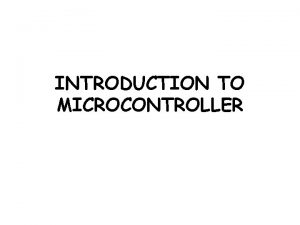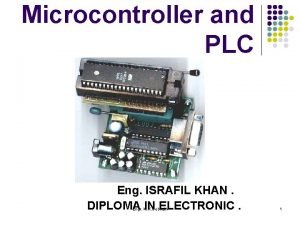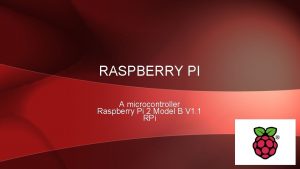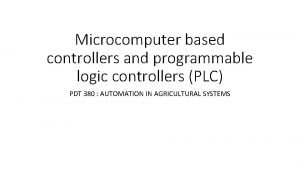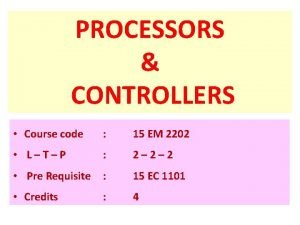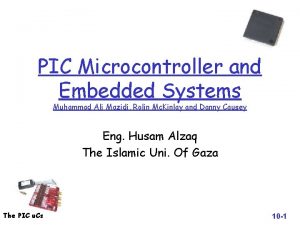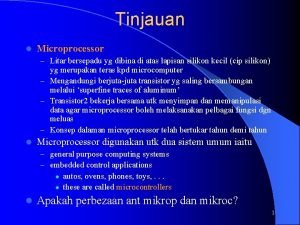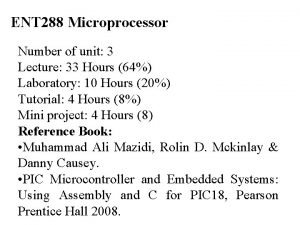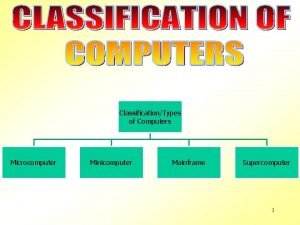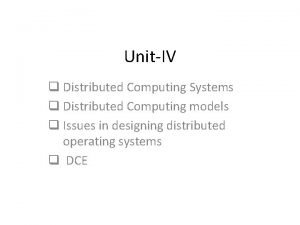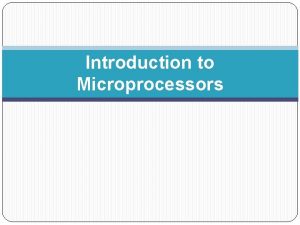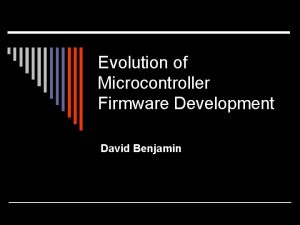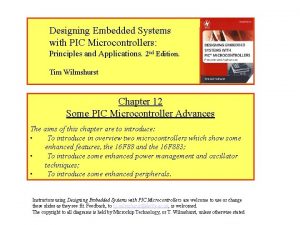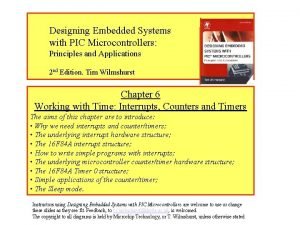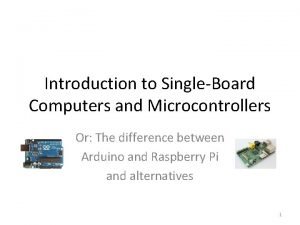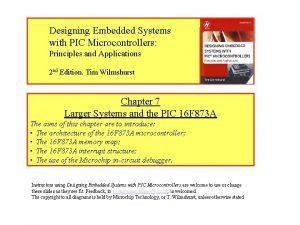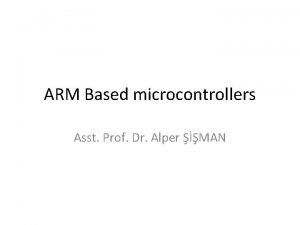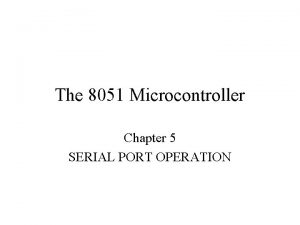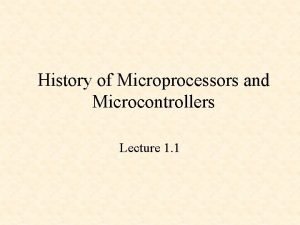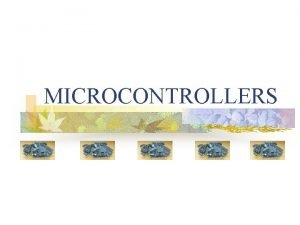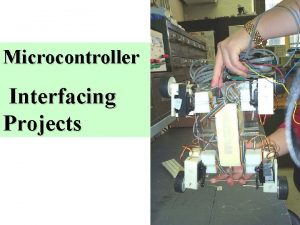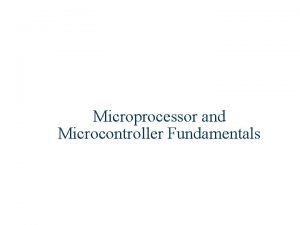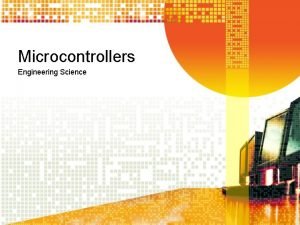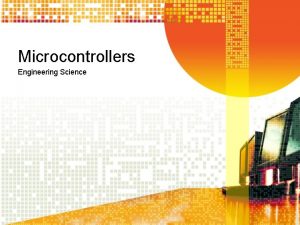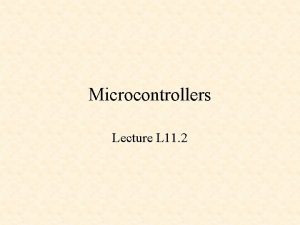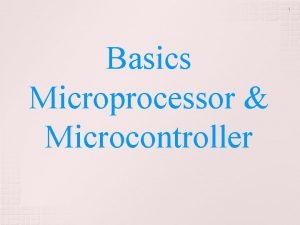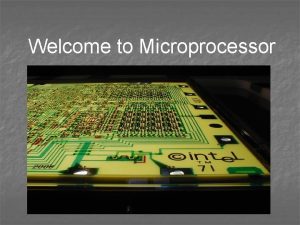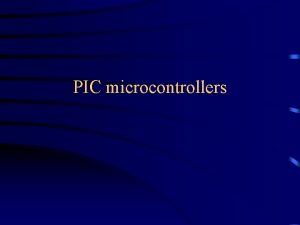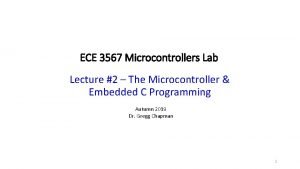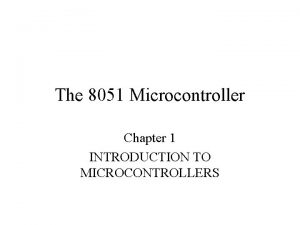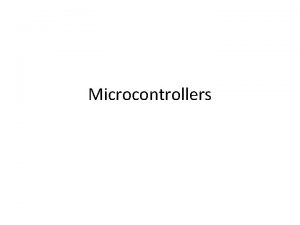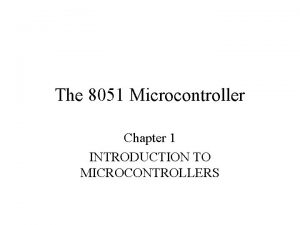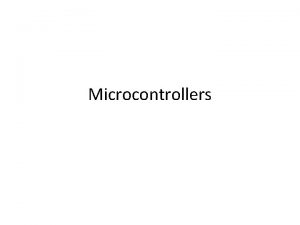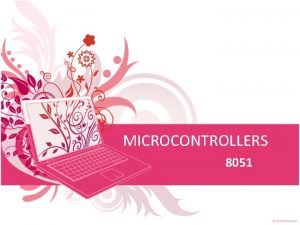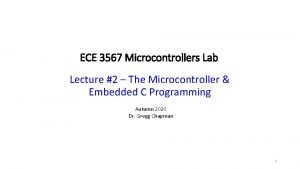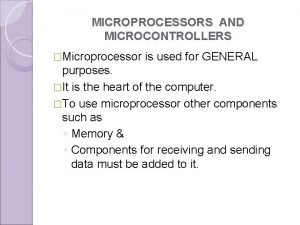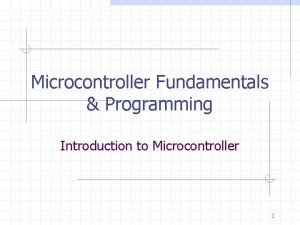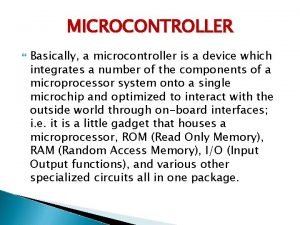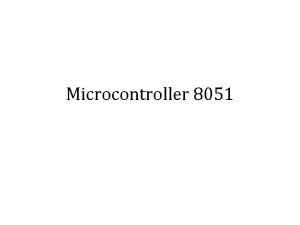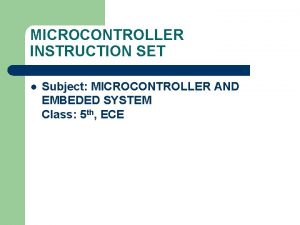Microcontrollers What is a Microcontroller MiniComputer Microprocessor The














































- Slides: 46

Microcontrollers

What is a Microcontroller? Mini-Computer ◦ Microprocessor The Brains Arithmetic Logic Unit (ALU) Control Unit Program/ Data Storage Peripherals (Input/Output) Low-Cost

Why Important? Embedded Inside: ◦ ◦ ◦ Automotive systems Airplanes Toys Medical Devices Furniture Billions of units

Available u. C in Bangladesh AT 89 C 51 AT 89 C 52 AT 89 S 51 AT 89 S 52 ATMEGA-8 AT 89 C 2051 AT 89 C 4051 AT 89 C 55 WD AT 89 S 8252 AT 90 S 2313 AT 90 S 8515 AT 90 S 8535 ATMEGA-16 ATMEGA-32 ATMEGA-64 ATMEGA-88 ATTINY-13 ATTINY-15 ATTINY-26 AT 89 C 51 ED 2 AT 89 C 51 RD 2 AT 91 RM 9200 AT 91 SAM 256 ATMEGA-128 ATMEGA-162 W 78 E 052 B 40 DL

Available u. C in Bangladesh PIC 16 F 72 PIC 16 F 74 PIC 16 F 77 PIC 10 F 200 PIC 12 F 629 PIC 16 C 54 C PIC 16 C 65 B PIC 16 F 676 PIC 18 F 452 PIC 16 F 628 A PIC 16 F 873 A PIC 16 F 877 A PIC 18 F 4550 PIC 16 F 73 PIC 16 F 76 PIC 16 F 88 PIC 12 F 508 PIC 12 F 675 PIC 16 C 57 C PIC 16 C 923 PIC 16 F 84 A PIC 16 C 622 A PIC 16 F 648 A PIC 16 F 876 A PIC 18 F 2550

PIC 16 F 877 A 40 -Pin Enhanced Flash, 8 -Bit CMOS Microcontrollers with Nano Watt Technology Wide operating voltage range (2. 0 V-5. 5 V) 33 I/O pins Two 8 -bit Timer, One 16 -bit Timer 8 -channel, 10 -bit ADC Programmable Serial USART Internal Calibrated RC Oscillator DC – 20 MHz oscillator/clock input Software selectable frequency range of 8 MHz to 32 k. Hz

Pin Diagram

What do I need to start? To start C programming language on Microchip PIC Microcontroller you need these following tools: Down load the latest Mikro. C and Install it The PIC 16 F 877 A datasheet Microchip Programmer. Trainer Board

I/O Port For Port A, B, C, D, E there are control bytes TRISx. Setting a TRISx bit (= 1) will make the corresponding PORTx pin an input Clearing a TRISx bit (= 0) will make the corresponding PORTx pin an output

TRISA and PORTA

TRISB and PORTB

TRISC and PORTC

TRISD and PORTD

TRISE and PORTE

Write the first code and simulate #include<pic. h> void main() { TRISA 0 = 1; TRISC = 0; ADCON 1=0 b 00000110; while (1) { if(PORTA == 0) { PORTC = 0; } else if (PORTA 0 == 1) { PORTC = 1; } } } // main function // declare RA 0 pin as input // declare POART C as output //declare RA 0 pin as digital // working loop

Open ISIS Professional from Proteus Program

Draw the circuit

Specify HEX file to Microcontroller

Simulate the Circuit with Microcontroller Program

Output current caution Ensure that the output current <20 m. A Maximum output current sunk by any I/O pin. . . . . . . 25 m. A Maximum output current sourced by any I/O pin. . . . . . 25 m. A Maximum current sunk by PORTA, PORTB and PORTC (combined). . . . 200 m. A Maximum current sourced PORTA, PORTB and PORTC (combined). . . . 200 m. A

Input

Input Arrangement For hardware side, use 1 uf-10 uf Capacitor across the push button if the input source is a push button. Solve the de-bouncing problem by programming accordingly.

Class work Write a program that ◦ takes input from RC 0 and RC 1 ◦ Output LED at RC 2 is light while any of the input is high ◦ Output LED as RC 3 is light while both of the inputs are high Simulate it and run it to the Microcontroller

◦ TRISC 0=1; // defined as input ◦ TRISC 1=1; // defined as input ◦ TRISC 2=0; // defined as output ◦ TRISC 3=0; // defined as output While(1){ RC 2=RC 0 | RC 1; RC 3= RC 0 &RC 1; }

Analog to Digital Converter 10 -bit Resolution 13 - 260 μs Conversion Time 8 Multiplexed Single Ended Input Channels 0 - VCC ADC Input Voltage Range Selectable 2. 56 V ADC Reference Voltage

Analog to Digital Converter 10 -bit Resolution

Analog to Digital Converter 8 Multiplexed Single Ended Input Channels

Analog to Digital Converter 0 - VCC ADC Input Voltage Range

Analog to Digital Converter Selectable 2. 56 V ADC Reference Voltage

A general diagram of ADC

Block Diagram

ADC Block Diagram(PIC 16 F 690)

Related Pins

Configuration Sequence Enable ADC Analog input channel declaration Channel Selection Clock Selection Start a conversion Wait until the conversion finishes When the conversion is done, read the 8 bit LSB from ADRESL and 2 bit MSB from ADRESH byte. Concatenate them to get 10 bit conversion

Configuration Bytes There are the registers available to control the functionality of the A/D module: 1. ADON=1 2. ADCS 2, 1, 0 3. CHS 2, 1, 0

Enabling ADC

Analog input channel declaration Set the corresponding TRISx bits to ‘ 1’ to set the pin output driver to its high-impedance state. Likewise, set the corresponding ANSx bit to disable the digital input buffer.

ADC

ADC clock source

CONVERSION OUTPUT The A/D conversion can be supplied in two formats: Left or right justified. The ADFM bit (ADCON 0<7>) controls the output format.

VOLTAGE REFERENCE There are two options for the voltage reference to the A/D converter: either VDD is used or an analog voltage applied to VREF is used. The VCFG bit (ADCON 0<6>)controls the voltage reference selection. If VCFG is set, then the voltage on the VREF pin is the reference; otherwise, VDD is the reference.

Voltage Reference(not applicable)

CONVERSION CLOCK The source of the conversion clock is software selectable via the ADCS bits (ADCON 1<6: 4>).

STARTING A CONVERSION The A/D conversion is initiated by setting the GO/DONE bit (ADCON 0<1>). When the conversion is complete, the A/D module: Clears the GO/DONE bit

ADC

 Advantages of microcontroller over microprocessor
Advantages of microcontroller over microprocessor Plc vs microcontroller
Plc vs microcontroller Raspberry pi 3 is microprocessor or microcontroller
Raspberry pi 3 is microprocessor or microcontroller Advantages of plc
Advantages of plc Difference between microcontroller and microprocessor
Difference between microcontroller and microprocessor Embedded systems
Embedded systems Litar bersepadu microchip
Litar bersepadu microchip Microprocessor and microcontroller difference
Microprocessor and microcontroller difference Mainframe and minicomputer era
Mainframe and minicomputer era Example of input device
Example of input device Characteristics of mainframe computer
Characteristics of mainframe computer Workstation model in distributed system
Workstation model in distributed system Introduction to microprocessors
Introduction to microprocessors Evolution of microcontroller
Evolution of microcontroller Designing embedded systems with pic microcontrollers
Designing embedded systems with pic microcontrollers Introduction to microcontrollers
Introduction to microcontrollers Yundong zhang
Yundong zhang Pic architecture diagram
Pic architecture diagram Microcontroller vs single board computer
Microcontroller vs single board computer Data memory
Data memory Arm based microcontrollers
Arm based microcontrollers The 8051 family of microcontroller has which serial port
The 8051 family of microcontroller has which serial port History of microcontrollers
History of microcontrollers Embedded innovator winter 2010
Embedded innovator winter 2010 What is a microcontroller?
What is a microcontroller? Hươu thường đẻ mỗi lứa mấy con
Hươu thường đẻ mỗi lứa mấy con Lời thề hippocrates
Lời thề hippocrates đại từ thay thế
đại từ thay thế Quá trình desamine hóa có thể tạo ra
Quá trình desamine hóa có thể tạo ra Vẽ hình chiếu vuông góc của vật thể sau
Vẽ hình chiếu vuông góc của vật thể sau Công thức tính độ biến thiên đông lượng
Công thức tính độ biến thiên đông lượng Thế nào là mạng điện lắp đặt kiểu nổi
Thế nào là mạng điện lắp đặt kiểu nổi Dot
Dot Vẽ hình chiếu đứng bằng cạnh của vật thể
Vẽ hình chiếu đứng bằng cạnh của vật thể Phản ứng thế ankan
Phản ứng thế ankan Bổ thể
Bổ thể Môn thể thao bắt đầu bằng chữ f
Môn thể thao bắt đầu bằng chữ f Khi nào hổ mẹ dạy hổ con săn mồi
Khi nào hổ mẹ dạy hổ con săn mồi điện thế nghỉ
điện thế nghỉ Một số thể thơ truyền thống
Một số thể thơ truyền thống Nguyên nhân của sự mỏi cơ sinh 8
Nguyên nhân của sự mỏi cơ sinh 8 Trời xanh đây là của chúng ta thể thơ
Trời xanh đây là của chúng ta thể thơ Số.nguyên tố
Số.nguyên tố Thiếu nhi thế giới liên hoan
Thiếu nhi thế giới liên hoan Vẽ hình chiếu vuông góc của vật thể sau
Vẽ hình chiếu vuông góc của vật thể sau Các châu lục và đại dương trên thế giới
Các châu lục và đại dương trên thế giới Thế nào là hệ số cao nhất
Thế nào là hệ số cao nhất
